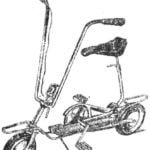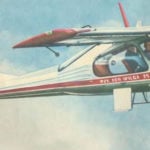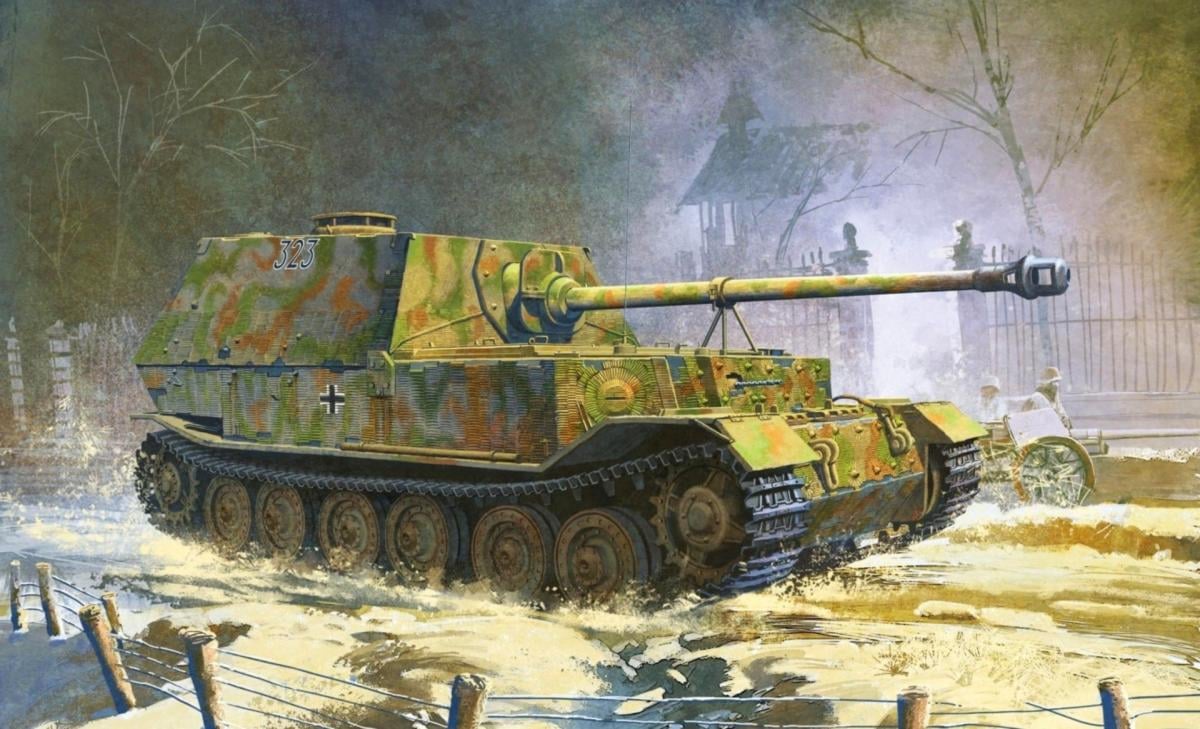 His appearance in the world’s most famous German self-propelled gun of the Second world war, Ferdinand was obliged, on the one hand, the intrigues around the heavy tank /K 4501 (P), and with another — the appearance of the 88-mm anti-tank gun Cancer 43. Tank /K 4501 (P) — simply put “Tiger” designs of Dr. Porsche, it was shown to Hitler on 20 April 1942, simultaneously with its rival VK 4501 (H) — “Tiger” Henschel company. According to Hitler, in serial production was supposed to be running both cars, which strongly resisted the arms Control, employees who couldn’t stand the shrew favorite of the Fuhrer — Dr. Porsche.
His appearance in the world’s most famous German self-propelled gun of the Second world war, Ferdinand was obliged, on the one hand, the intrigues around the heavy tank /K 4501 (P), and with another — the appearance of the 88-mm anti-tank gun Cancer 43. Tank /K 4501 (P) — simply put “Tiger” designs of Dr. Porsche, it was shown to Hitler on 20 April 1942, simultaneously with its rival VK 4501 (H) — “Tiger” Henschel company. According to Hitler, in serial production was supposed to be running both cars, which strongly resisted the arms Control, employees who couldn’t stand the shrew favorite of the Fuhrer — Dr. Porsche.
Tests have not revealed any obvious advantages of one machine over another, but the willingness to produce “the Tiger,” the Porsche was higher — by 6 June 1942 to surrender to the troops were ready first 16 tanks VK 4501 (P), for which the firm Krupp were finishing the Assembly of the towers. Firm Henschel could pass by that time only one car, and that without the tower. The first battalion equipped with “tigers” Porsche, it was assumed to form in August 1942 and send to Stalingrad, but suddenly the armaments Department stopped all work on the tank for a month.
Managers used the orders of Hitler on the establishment of assault guns on the basis of the Pz.IV and the VK 4501, armed with the latest 88-mm anti-tank gun Cancer 43/2 with a barrel length of 71 caliber. With the filing of the Control arms and it was decided to redo all the 92 is ready and placed in the Assembly on the shop floors Nibelungenwerke chassis VK 4501 (P) to assault guns.
In September 1942, the work began. The design was made by Porsche in conjunction with the designers of the Berlin plant Alkett. Because of the tank’s cabin was located aft, the chassis had to be changed by placing the motors and generators in the middle of the body. Originally it was planned to collect new ACS in Berlin, but this had to be abandoned because of difficulties related to transportation by rail, and from-for unwillingness to discontinue production of assault guns StuG III, the main products of the plant Alkett. As a result, the Assembly of ACS, which received the official designation 8,8 cm Pak 43/2 Sfl L/71. Tiger(P) Sd.Kfz. 184 Ferdinand and title (awarded personally by Hitler in February 1943, in deference to Dr. Ferdinand Porsche), produced at the plant Nibelungenwerke.
Frontal 100-mm sheets of the hull of Tiger(P) was also enhanced 100-mm armor plates attached to the hull with bolts and bullet-proof head. Thus the frontal armor of the hull was brought to 200 mm, the Same thickness and had a front plate cutting. The thickness of the side and stern sheets up to 80 mm (according to other sources 85 mm). Armor plates of the wheelhouse connected “to spike” and were reinforced by dowels, and then obvallaris. The cabin is attached to the housing with brackets and bolts with bullet-proof head.
In the front of the case housed the seat of the driver and radio operator. Behind them, in the center of the machine, parallel to each other equipped with two 12-cylinder carbureted V-shaped liquid-cooled engine Maybach HL 120TRM output of 265 HP (at 2600 rpm) each. The engine drives the rotation of the rotors of the two generators Siemens Typ aGV, which, in turn, supplied electricity to the two traction motor Siemens D1495aAC power of 230 kW each installed in the rear part of the vehicle beneath the crew compartment. The torque from electric motors with Electromechanical side gear is transmitted to the drive wheels aft of the location. In an emergency or in the event of combat damage to one of the branches of power provided for its duplication.
Cancer 8.8 cm 43/2 Ferdinand
8.8 cm 43/2 Cancer Elefant
Suspension “Ferdinand” in relation to the same Board consisted of six road wheels with internal shock absorption, semi-detached pairs in three trucks with the original, very complex, but highly efficient Parchevsky with suspension system with longitudinal torsion bars, tested still at the experimental chassis of the VK 3001 (P). The driving wheel had a removable ring gears with 19 teeth each. Idler also had the gear rims, which excluded unmarried rewind tracks.
Each caterpillar consisted of 109 trucks with a width of 640 mm.
In the cockpit, the axles special machine was installed 88-mm gun Cancer 43/2 (self-propelled version — StuK 43) with a barrel length of 71 caliber, developed on the basis of anti-aircraft gun Flak 41. The horizontal angle of the guidance did not exceed the sector of 28°. The elevation angle of +14°, declination -8°. The mass of 2200 kg. the guns Recess into the frontal cutting was covered by a massive cast mask pear-shaped, attached to the machine. However, the design of the mask was not too successful and did not provide full protection from a bullet of lead spray and the small fragments that penetrated into the body through gaps between the mask and the frontal sheet. Therefore, masks the most part “ferdinandov” reinforced armor plates. In gun ammunition consisted of 50 unitary shots posted on the walls of the cabin. In the aft part of the cabin there was a round hatch designed to remove the gun.
According to German reports, the armor-piercing projectile There is a 39/43 weight of 10.16 kg and initial speed of 1000 m/s punched at a distance of 1000 m 165-mm armor (at an angle of meeting of 90°), and piercing projectiles I’m 40/43 weight of 7.5 kg and an initial speed of 1130 m/s — 193 mm, which provided “Ferdinand” unconditional defeat of any of the then existing tanks.
The Assembly of the first machine began on February 16 and the last nineties Ferdinand left the factory shops may 8, 1943. In April, the first production vehicle was tested on the Kummersdorf proving ground.
Baptism of fire “Ferdinand” received in the course of the operation “Citadel” in the 656 th regiment of tank destroyers, which included 653 and 654 th battalions (schwere Abteilung. — sPz.Jäger Abt.). By the beginning of the battles in the first were 45 and the second 44 “Ferdinand”. Both division were under the operational control of the 41st Panzer corps, took part in heavy fighting on the Northern fase Kursk bulge near the station ponyri (654 th division) and the village of Warm (653 division).
Especially heavy losses suffered 654 division mainly in the minefields. On the battlefield there are 21 “Ferdinand”. Damaged and destroyed near the station ponyri German equipment was surveyed on 15 July 1943, the representatives of GAU and Netpoolone the red Army. Most of the “ferdinands” were in a mine field filled with land mines from captured large-caliber shells and bombs. More than half of the cars had damage to the suspension; the broken track, destroyed road wheels, etc. five “ferdinandov” damage undercarriage was caused by the falling shells of caliber of 76 mm and more. Two German self-propelled guns guns guns was riddled with shells and bullets of anti-tank guns. One car was destroyed by a direct hit bombs, and one more — hit 203-mm howitzer projectile in the roof of the cabin.
Only one destroyer of this type that were fired in different directions seven T-34 tanks and a battery of 76-mm guns, had a hole in the Board, in the center of the drive wheel. Another “Ferdinand” had no damages of the hull and running gear was set on fire by a Molotov cocktail thrown by our soldiers.
The only worthy opponent of German heavy self-propelled guns were Soviet SU-152. Regiment SU-152 fired on 8 July 1943, attacking the “Ferdinand” 653 th battalion, knocked out four enemy machines. All in all, July — August 1943, the Germans lost 39 “ferdinandov”. Recent trophies went to the red Army on the outskirts of Eagle — at the railway station was captured a few prepared to evacuate damaged assault guns.
The first battles of “Ferdinand” at Kursk became, in fact, and the latter, where the ACS used in large quantities. From a tactical point of view, their use left much to be desired. Designed for the destruction of Soviet medium and heavy tanks at long distances, they were used as advanced “armor shield”, blindly ramming engineering barriers and anti-tank defenses incurring great losses. However, the moral effect of the appearance on the Soviet-German front was largely invulnerable to German self-propelled guns was very large. There was “ferdinandiana and ferdinandovac”. Judging from the literature, it was not the red Army soldier, who was not knocked out or, at least, was not involved in a battle with the “Ferdinand”. They were crawling on our positions on all fronts since 1943 (and sometimes even earlier) until the end of the war. The number of “padded” “ferdinandov” approaching several thousands. To explain this phenomenon is the fact that most of the red army are poorly understood in all sorts of “murderah”, “bison” and “neshamah” and called any German self-propelled gun “Ferdinand”, which shows how great was his “popularity” among our soldiers. Well, except for the padded “Ferdinand” without further ADO gave the order.
![The layout is]()
The layout is “elephant” (track circuit conventionally not shown):
1 — 88-mm gun; 2 — armor shield on the mask; 3 — periscopic sight; 4 — commander’s cupola; 5 — fan; 6 — hatch periscope surveillance device; 7 — stacking 88-mm rounds into the wall of the fighting compartment; 8 — motor; 9 — driving wheel; 10 — truck suspension; 11 —engine; 12 — generator; 13 — seat gunner; 14 — seat driver; 15 — ypravlaushiy wheel; 16 — a machine gun course
After the ignominious conclusion of the operation “Citadel” remaining in service “Ferdinand” were deployed to Zhitomir and Dnipropetrovsk, where they began repairs and replacement of tools, caused by a strong height of the stems. In late August, the personnel of the 654 th division was sent to France for reorganization and rearmament. While the ACS, he handed 653 division, which in October — November, took part in defensive battles in the area of Nikopol and Dnepropetrovsk. In December the division left the front edge and was sent to Austria.
For the period from 5 July (the beginning of operation “Citadel”) on 5 November 1943 “ferdinands” 656 th regiment knocked out the Soviet 582 tanks, 344 anti-tank guns, 133 guns, 103 anti-tank guns, three aircraft, three armored cars and three self-propelled guns*.
In the period from January to March 1944 the Nibelungenwerke factory was modernized 47 remaining by the time “ferdinandov”. In the frontal armor of the hull on the right was installed in the ball installation machine gun MG 34. On the top of the cabin appeared a commander’s cupola borrowed from the assault gun StuG 40. The shield on the gun barrel is launched “backwards” to the best of his mounts, as well as equipped with shields, those ACS that it had not. Ammunition brought up to 55 shots. The cars name was changed to Elefant (elephant). However, until the end of the war self-propelled gun often called the familiar name of “Ferdinand”.
At the end of February 1944 the 1st company of the 653-th division was sent to Italy, where she participated in the battle of Anzio, and in may — June, 1944, near Rome. At the end of June the company, which had two healthy, “elefanta”, was transferred to Austria.
In April 1944 the 653-th division consisting of two companies were sent to the Eastern front, in the district of Ternopil. There during the fighting the division lost 14 cars, but 11 of them were repaired and back in service again. In July the division already retreating through Poland, there were 33 self-propelled guns serviceable. However, on July 18 653 division without intelligence and training were thrown into battle to the rescue of the 9th SS Panzer division Hohenstaufen and in a day the number of combat vehicles in its ranks dropped by more than half. Soviet troops rather successfully used against the “Elefant” their heavy artillery and 57-mm anti-tank gun. Part of the German cars were only damaged and completely beyond repair, but because of the impossibility of evacuation they blew up or set fire to their own crews. Remnants of division 12 efficient machines — August 3, was taken to Krakow. In October 1944, the division began to receive ACS Jagdtiger, and the remaining in the ranks “Elefante” were summarized in 614-th heavy anti-tank company.

Until the beginning of 1945, the company was in reserve of the 4th Panzer army, and on 25 February she was transferred to the area of Wünsdorf to strengthen anti-tank defense. At the end of April “Elefante” has spent the last battles in Wünsdorf and Zossen in the so-called group of Ritter’s (captain Ritter was the commander of the 614-th battery).
Surrounded by Berlin’s last two self-propelled guns, “elephant” was hit in the district of Karl-August, and Church.Trinity.
To our days there were two self-propelled guns of this type. In the Museum of armored vehicles in Kubinka exhibited Ferdinand was captured by the red Army during the battle of Kursk, and the Aberdeen proving ground Museum in the USA — “elephant”, which went to the Americans in Italy, in Anzio.
THE PERFORMANCE CHARACTERISTICS OF ACS “FERDINAND”
Combat weight, t……………………….65
Crew………………………………6
Overall dimensions, mm:
length……………………………….8140
width…………………………….3380
height……………………………..2970
clearance……………………………..480
The thickness of armor, mm:
forehead hull and deckhouse…………….200
Board and feed ………………………..80
roof………………………………….30
the bottom………………………………….20
Maximum speed, km/h:
on the highway……………………………..20
on the terrain………………………..11
Cruising range, km:
on the highway……………………………150
on the terrain………………………..90
Overcoming obstacles:
the angle of elevation, deg………………..22
the width of the ditch, m……………………2,64
wall height, m………………..0,78
fording depth, m…………………….1
The length of support
surface, mm………………..4175
Specific pressure, kg/cm2……..1,23
Specific power, HP/t….about 8
M. BARYATINSKY
Recommend to read
 ROLLER-LED
ROLLER-LED
It seems incredible that sparkling chrome valarelli, one of the many exhibits Central exhibition HTTM-82, manufactured by teenagers — it is very "factory" looking. And still made him the... IVOLGA — air taxi
IVOLGA — air taxi
The Wilga is Polish "Ivolga". Indeed, this iisna white-winged machine with widely spread wings and forward, powerful paws-chassis resembles a bird, aimed ia a rapid breakthrough. A...
 His appearance in the world’s most famous German self-propelled gun of the Second world war, Ferdinand was obliged, on the one hand, the intrigues around the heavy tank /K 4501 (P), and with another — the appearance of the 88-mm anti-tank gun Cancer 43. Tank /K 4501 (P) — simply put “Tiger” designs of Dr. Porsche, it was shown to Hitler on 20 April 1942, simultaneously with its rival VK 4501 (H) — “Tiger” Henschel company. According to Hitler, in serial production was supposed to be running both cars, which strongly resisted the arms Control, employees who couldn’t stand the shrew favorite of the Fuhrer — Dr. Porsche.
His appearance in the world’s most famous German self-propelled gun of the Second world war, Ferdinand was obliged, on the one hand, the intrigues around the heavy tank /K 4501 (P), and with another — the appearance of the 88-mm anti-tank gun Cancer 43. Tank /K 4501 (P) — simply put “Tiger” designs of Dr. Porsche, it was shown to Hitler on 20 April 1942, simultaneously with its rival VK 4501 (H) — “Tiger” Henschel company. According to Hitler, in serial production was supposed to be running both cars, which strongly resisted the arms Control, employees who couldn’t stand the shrew favorite of the Fuhrer — Dr. Porsche.





